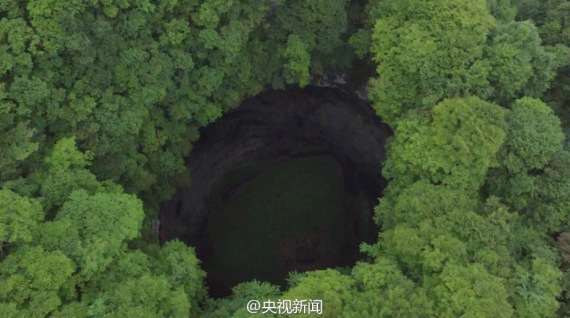
A cluster of giant karst sinkholes has been discovered in northwest China's Shaanxi Province.( Photo/CCTV Weibo)
A cluster of giant karst sinkholes, also known as tiankengs, has been discovered in northwest China's Shaanxi Province, one of the largest tiankeng clusters in the world, geologists announced Thursday.
In total, 49 tiankengs and over 50 funnels of between 50 to 100 meter in diameter were found in the over 200-km karst landform belt in Hanzhong City, said Liu Tongliang, head of the karst geology research institute under the Chinese Academy of Geological Sciences (CAGS).
The belt, located between 32 and 33 degrees north latitude, is the northernmost karst landform region ever found in the world. All previous discoveries were between 24 and 31 degrees north latitude, said Liu.
The cluster was first found last February by a national geological exploration team. From Oct. 25 to 28 this year, resource authorities in Shaanxi led a team composed of experts from UNESCO International Research Center on Karst, International Union of Speleology and other research bodies of Czech, France and China to jointly surveyed the region .
"The expert panel agreed, the Hanzhong tiankeng cluster is rare, complete and spectacular in landscape. It has met international geological standards and has potential scientific and tourism value," said Wang Weihua, chief of Department of Land and Resources of Shaanxi.
According to Gou Runxiang, head of Shaanxi provincial research institute of geology research, before this cluster was found, there were only 130 tiankengs in the world, with over 90 in China.
Among the 49 newly-discovered pits, there are one super-sized, 17 large and 31 regular ones. A super-sized tiankeng means over 500 meters in diameter, a large one is between 300 and 500 meters, and a regular one over 100 meters in both depth and diameter.
CAGS geologist Liu said apart from its significance for karst landform research, the belt has also offered an opportunity for biological research.
He said the special landform had created suitable habitat for plants and animals and the ecology of the belt's core area remains intact because it is difficult to access.
Tiankengs are dolines, or giant pits, with special geological features found in karst regions formed by repeated cave-ins. They are mainly found in China, Mexico and Papua New Guinea. In 2001, geologist Zhu Xuewen proposed the Chinese name "Tiankeng" for dolines over 100 meters in depth, as there was no special term yet to define this unique geological feature.


















































